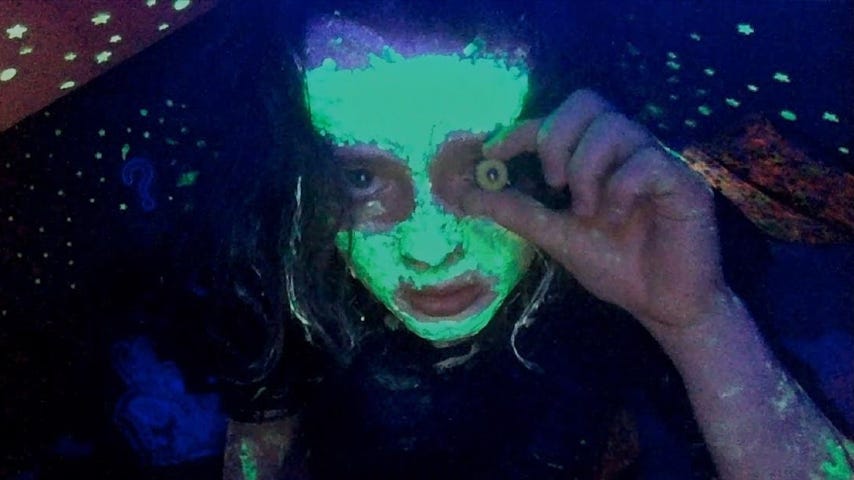There used to be more internets. The gradual condensation of thousands of forums, HTML pages, and hyperlink rabbit holes into no more than a dozen aggregate websites has made the scope of the digital connectivity more overwhelming and easier to quantify, imbued with the paranoia of surveillance. You are irrevocably witnessable and disempowered on the Internet, access to platforms conditional on your adherence in expression. The architecture of these websites is anonymous, generic, and dissociative.
The internet of Jane Schoenbrun We’re All Going to the World’s Fair is different - it’s not the gentle mess of Adobe Flash assets that you encounter in Nina Freeman’s Cibele, or the hyperconnective infodump of the great American Vandal. It’s closest to Pulse, but even that movie gives the technology a sublime quality that World’s Fair smartly disallows. The film lives unknown in the recesses of Youtube and Skype. This is not the savvy end of the internet. This is a bit less cool, less social, far removed from any modern trends, the kind of internet you find alone at 13. This is what the internet feels like when you operate under the assumption that nobody will ever discover you because nobody has ever tried.
In this context, We’re All Going to the World’s Fair pulls the first of its many great tricks; It lets you go outside. Shot in upstate New York, the empty parking lots and highways and valleyed highways read with an almost imperceptible certainty as the Northeast. There are no people but there is space that does not feel suitable for anything except solitude. The prospect of direct interaction is terrifying; even the brief, off-screen appearance of the main character’s brother feels intrusive.
Anna Cobb stars as Casey, an online pseudonym used in place of her real name, which is never uttered. We see her first in a Photo Booth video, participating in an ARG ritual. She wants to go the World’s Fair. After this deliberate opening (which authentically evokes slow cinema in a way lesser films of its ilk often fail), you’d be forgiven for expecting the film to operate sans conventional dramatics, and you’d be half-right. Though it’s decidedly less than conventional, one of the richest surprises fo World’s Fair is how it toys with audience sympathies and assumptions as adeptly as the works of Mike Leigh or Edith Wharton. It’s startling how narratively *tight* the film reveals itself to be, how well constructed on a script-level the film is, a rarity in American film outside of genre work.
Speaking of genre, World’s Fair isn’t really a horror movie. In a similar vein to Gone Home, the spooky aesthetics are pretense for accessing honesty, communicating the comfort horror provides for socially outcast adolescents. Anna Cobb is extraordinary, and a scene where she reads tarot to a webcam exudes the bravura of a great actor. The only other named character in the film is JLB, an older man played by Michael J. Rogers, who refuses to turn on his camera. He reaches out to Casey, saying he knows about the lore of the World’s Fair, and wants to walk her through this journey. “We can be scared together. Keep posting videos so I know you’re okay.”
Early on in We’re All Going to the World’s Fair, we see our first loading screen. The arrows phasing in and out of a circle between an ASMR video and a creepypasta message. This is the algorithm announcing its presence, a spectral guide. The pain you feel will find you and the people who feel it will too.
It should be mentioned that We’re All Going to the World’s Fair is about dysphoria. This central, impossible to fully articulate experience is the core of the film, the black hole of suffering around which everything orbit. When Casey explains what the World’s Fair Challenge is doing to her, she says she feels nothing in her body, that it’s different from what everyone told her it would be; She cannot even process it as it takes her over. The film avoids, with one notable exception, anything resembling explicit body horror, the preferred dysphoria genre. It avoids, too, typical screaming melodrama whose negative space is often reclaimed by trans people. It moves beyond the need to be allegorically legible, opting for a much richer formal and emotional communication. Schoenbrun, who is nonbinary, lets their film speak in whispers.
I want to avoid discussing particulars of the film’s latter half, though I’d be remiss if I didn’t mention in passing the stunning assuredness with which it juggles an ever-escalating cacophony of emotional states: the pain of someone suffering on the other end of a screen, a feeling so common amongst trans people that it is understood wordlessly, the cruelty of a teenager terrified of being an adult, the radical forgiveness and shocking healing that drives the film’s finale. That Schoenbrun gives the trans audience, like Casey, space, even for just a moment, to be seen in suffering, to give her and us the safety to do that, is a difficult and miraculous instance of cinema.
There’s so much more to say about the film; The way the amateur horror films begin to influence Casey’s mise-en-scene, the interlude on New Year’s Eve, the awkward positions and places within the house where Casey scrambles to watch videos. I’ve seen it twice and I can’t wait to revisit it. It’s a rare and honest and great piece of art, one so specifically healing for me. It is the first film that ever felt like my adolescence.





This is easily the best pieces I've seen of this really good film thus far.